ASUS P4VP-MX User Manual

P4VP-MX
User Guide
Motherboard

E1877
Revised Edition V2
January 2005
Copyright © 2005 ASUSTeK COMPUTER INC. All Rights Reserved.
No part of this manual, including the products and software described in it, may be reproduced, transmitted, transcribed, stored in a retrieval system, or translated into any language in any form or by any means, except documentation kept by the purchaser for backup purposes, without the express written permission of ASUSTeK COMPUTER INC. (“ASUS”).
Product warranty or service will not be extended if: (1) the product is repaired, modified or altered, unless such repair, modification of alteration is authorized in writing by ASUS; or (2) the serial number of the product is defaced or missing.
ASUS PROVIDES THIS MANUAL “AS IS” WITHOUT WARRANTY OF ANY KIND, EITHER EXPRESS OR IMPLIED, INCLUDING BUT NOT LIMITED TO THE IMPLIED WARRANTIES OR CONDITIONS OF MERCHANTABILITY OR FITNESS FOR A PARTICULAR PURPOSE. IN NO EVENT SHALL ASUS, ITS DIRECTORS, OFFICERS, EMPLOYEES OR AGENTS BE LIABLE FOR ANY INDIRECT, SPECIAL, INCIDENTAL, OR CONSEQUENTIAL DAMAGES (INCLUDING DAMAGES FOR LOSS OF PROFITS, LOSS OF BUSINESS, LOSS OF USE OR DATA, INTERRUPTION OF BUSINESS AND THE LIKE), EVEN IF ASUS HAS BEEN ADVISED OF THE POSSIBILITY OF SUCH DAMAGES ARISING FROM ANY DEFECT OR ERROR IN THIS MANUAL OR PRODUCT.
SPECIFICATIONS AND INFORMATION CONTAINED IN THIS MANUAL ARE FURNISHED FOR INFORMATIONAL USE ONLY, AND ARE SUBJECT TO CHANGE AT ANY TIME WITHOUT NOTICE, AND SHOULD NOT BE CONSTRUED AS A COMMITMENT BY ASUS. ASUS ASSUMES NO RESPONSIBILITY OR LIABILITY FOR ANY ERRORS OR INACCURACIES THAT MAY APPEAR IN THIS MANUAL, INCLUDING THE PRODUCTS AND SOFTWARE DESCRIBED IN IT.
Products and corporate names appearing in this manual may or may not be registered trademarks or copyrights of their respective companies, and are used only for identification or explanation and to the owners’ benefit, without intent to infringe.
ii

Contents
Notices ............................................................................................ |
v |
Safety information .......................................................................... |
vi |
About this guide............................................................................. |
vii |
ASUS contact information ............................................................ |
viii |
P4VP-MX specifications summary ................................................. |
ix |
Chapter 1: Product introduction
1.1 |
Welcome! ........................................................................... |
1-2 |
|
1.2 |
Package contents ............................................................... |
1-2 |
|
1.3 |
Special features.................................................................. |
1-3 |
|
1.4 |
Motherboard components .................................................. |
1-4 |
|
1.5 |
Motherboard layout ............................................................ |
1-7 |
|
1.6 |
Before you proceed ............................................................ |
1-8 |
|
1.7 |
Motherboard installation ..................................................... |
1-9 |
|
|
1.7.1 |
Placement direction ............................................... |
1-9 |
|
1.7.2 |
Screw holes ........................................................... |
1-9 |
1.8 |
Central Processing Unit (CPU)......................................... |
1-10 |
|
|
1.8.1 |
Overview .............................................................. |
1-10 |
|
1.8.2 |
Installing the CPU ................................................. |
1-11 |
1.9 |
System memory ............................................................... |
1-12 |
|
|
1.9.1 |
Installing a DIMM ................................................. |
1-12 |
1.10 |
Expansion slots ................................................................ |
1-13 |
|
|
1.10.1 |
Standard interrupt assignments ........................... |
1-13 |
|
1.10.2 |
IRQ assignments for this motherboard ................ |
1-13 |
|
1.10.3 |
PCI slots .............................................................. |
1-14 |
|
1.10.4 |
AGP slot ............................................................... |
1-14 |
1.11 |
Jumper |
............................................................................. |
1-15 |
1.12 |
Connectors ....................................................................... |
1-17 |
|
Chapter 2: BIOS information
2.1 |
Managing and updating your BIOS .................................... |
2-2 |
|
2.1.1 Creating a bootable floppy disk ............................. |
2-2 |
|
2.1.2 Using AFUDOS to update the BIOS ...................... |
2-2 |
|
2.1.3 Using ASUS EZ Flash to update the BIOS ............ |
2-3 |
|
2.1.4 Recovering the BIOS with CrashFree BIOS 2 ....... |
2-5 |
2.2 |
BIOS Setup program .......................................................... |
2-6 |
|
2.2.1 BIOS menu screen ................................................ |
2-7 |
iii

Contents
|
2.2.2 |
Menu bar ................................................................ |
2-7 |
|
2.2.3 |
Navigation keys ..................................................... |
2-7 |
|
2.2.4 |
Menu items ............................................................ |
2-8 |
|
2.2.5 |
Sub-menu items ..................................................... |
2-8 |
|
2.2.6 |
Configuration fields ................................................ |
2-8 |
|
2.2.7 |
Pop-up window ...................................................... |
2-8 |
|
2.2.8 |
Scroll bar ................................................................ |
2-8 |
|
2.2.9 |
General help .......................................................... |
2-8 |
2.3 |
Main menu.......................................................................... |
2-9 |
|
|
2.3.1 |
System Time .......................................................... |
2-9 |
|
2.3.2 |
System Date .......................................................... |
2-9 |
|
2.3.3 |
Legacy Diskette A, B .............................................. |
2-9 |
|
2.3.4 |
Primary/Secondary IDE Master/Slave ................. |
2-10 |
|
2.3.5 |
System Information ............................................... |
2-11 |
2.4 |
Advanced menu ............................................................... |
2-12 |
|
|
2.4.1 |
CPU Configuration ............................................... |
2-12 |
|
2.4.2 |
Chipset ................................................................. |
2-13 |
|
2.4.3 |
Onboard Devices Configuration ........................... |
2-15 |
|
2.4.4 |
PCI PnP ............................................................... |
2-17 |
2.5 |
Power menu ..................................................................... |
2-18 |
|
|
2.5.1 |
Suspend Mode [Auto] .......................................... |
2-18 |
|
2.5.2 Repost Video on S3 Resume............................... |
2-18 |
|
|
2.5.3 |
ACPI 2.0 Support ................................................. |
2-18 |
|
2.5.4 |
ACPI APIC Support .............................................. |
2-18 |
|
2.5.5 |
APM Configuration ............................................... |
2-19 |
|
2.5.6 |
Hardware Monitor ................................................ |
2-21 |
2.6 |
Boot menu ........................................................................ |
2-22 |
|
|
2.6.1 |
Boot Device Priority ............................................. |
2-22 |
|
2.6.2 |
Boot Settings Configuration ................................. |
2-23 |
|
2.6.3 |
Security ................................................................ |
2-24 |
2.7 |
Exit menu ......................................................................... |
2-26 |
|
Chapter 3: Software support
3.1 |
Install an operating system................................................. |
3-2 |
|
3.2 |
Support CD information ...................................................... |
3-2 |
|
|
3.2.1 Running the support CD ........................................ |
3-2 |
|
|
3.2.2 |
Drivers menu ......................................................... |
3-3 |
|
3.2.3 |
Utilities menu ......................................................... |
3-3 |
|
3.2.4 |
ASUS Contact Information ..................................... |
3-4 |
iv

Notices
Federal Communications Commission Statement
This device complies with Part 15 of the FCC Rules. Operation is subject to the following two conditions:
•This device may not cause harmful interference, and
•This device must accept any interference received including interference that may cause undesired operation.
This equipment has been tested and found to comply with the limits for a Class B digital device, pursuant to Part 15 of the FCC Rules. These limits are designed to provide reasonable protection against harmful interference in a residential installation. This equipment generates, uses and can radiate radio frequency energy and, if not installed and used in accordance with manufacturer’s instructions, may cause harmful interference to radio communications. However, there is no guarantee that interference will not occur in a particular installation. If this equipment does cause harmful interference to radio or television reception, which can be determined by turning the equipment off and on, the user is encouraged to try to correct the interference by one or more of the following measures:
•Reorient or relocate the receiving antenna.
•Increase the separation between the equipment and receiver.
•Connect the equipment to an outlet on a circuit different from that to which the receiver is connected.
•Consult the dealer or an experienced radio/TV technician for help.
The use of shielded cables for connection of the monitor to the graphics card is required to assure compliance with FCC regulations. Changes or modifications to this unit not expressly approved by the party responsible for compliance could void the user’s authority to operate this equipment.
Canadian Department of Communications Statement
This digital apparatus does not exceed the Class B limits for radio noise emissions from digital apparatus set out in the Radio Interference Regulations of the Canadian Department of Communications.
This class B digital apparatus complies with Canadian ICES-003.
v

Safety information
Electrical safety
•To prevent electrical shock hazard, disconnect the power cable from the electrical outlet before relocating the system.
•When adding or removing devices to or from the system, ensure that the power cables for the devices are unplugged before the signal cables are connected. If possible, disconnect all power cables from the existing system before you add a device.
•Before connecting or removing signal cables from the motherboard, ensure that all power cables are unplugged.
•Seek professional assistance before using an adpater or extension cord. These devices could interrupt the grounding circuit.
•Make sure that your power supply is set to the correct voltage in your area. If you are not sure about the voltage of the electrical outlet you are using, contact your local power company.
•If the power supply is broken, do not try to fix it by yourself. Contact a qualified service technician or your retailer.
Operation safety
•Before installing the motherboard and adding devices on it, carefully read all the manuals that came with the package.
•Before using the product, make sure all cables are correctly connected and the power cables are not damaged. If you detect any damage, contact your dealer immediately.
•To avoid short circuits, keep paper clips, screws, and staples away from connectors, slots, sockets and circuitry.
•Avoid dust, humidity, and temperature extremes. Do not place the product in any area where it may become wet.
•Place the product on a stable surface.
•If you encounter technical problems with the product, contact a qualified service technician or your retailer.
vi

About this guide
Conventions used in this guide
To make sure that you perform certain tasks properly, take note of the following symbols used throughout this manual.
WARNING: Information to prevent injury to yourself when trying to complete a task.
CAUTION: Information to prevent damage to the components when trying to complete a task.
IMPORTANT: Information that you MUST follow to complete a task.
NOTE: Tips and additional information to aid in completing a task.
Where to find more information
Refer to the following sources for additional information and for product and software updates.
1.ASUS Websites
The ASUS websites worldwide provide updated information on ASUS hardware and software products. The ASUS websites are listed in the ASUS Contact Information on page viii.
2.Optional Documentation
Your product package may include optional documentation, such as warranty flyers, that may have been added by your dealer. These documents are not part of the standard package.
vii

ASUS contact information
ASUSTeK COMPUTER INC. (Asia-Pacific)
Address |
15 Li-Te Road, Peitou, Taipei, Taiwan 112 |
Telephone |
+886-2-2894-3447 |
Web site |
www.asus.com.tw |
Technical Support |
|
Telephone(MB/Component) |
+886-2-2890-7121 (English) |
(Notebook) |
+886-2-2890-7122 (English) |
(Server/PC) |
+886-2-2890-7123 (English) |
(Networking) |
+886-2-2890-7902 (English) |
Support fax |
+886-2-2890-7698 |
ASUS COMPUTER INTERNATIONAL (America)
Address |
44370 Nobel Drive, Fremont, CA 94538, USA |
Fax |
+1-510-608-4555 |
tmd1@asus.com |
|
Web site |
usa.asus.com |
Technical Support |
|
Telephone (General) |
+1-502-995-0883 |
(Notebook) |
+1-510-739-3777 |
Support fax |
+1-502-933-8713 |
Support e-mail |
tsd@asus.com |
ASUS COMPUTER GmbH (Germany and Austria)
Address |
Harkort Str. 25, D-40880 Ratingen, Germany |
Telephone |
+49-2102-95990 |
Fax |
+49-2102-959911 |
Online contact |
www.asuscom.de/sales |
Technical Support |
|
Telephone |
+49-2102-95990 |
Fax |
+49-2102-959911 |
Online support |
www.asuscom.de/support |
Web site |
www.asuscom.de/news |
viii

P4VP-MX specifications summary
|
CPU |
Socket 478 for Intel® Pentium® 4 CPUs |
|
|
|
|
Supports Intel® Prescott CPU |
|
|
|
|
Supports Intel® Hyper-Threading Technology |
|
|
|
Chipset |
|
|
|
|
NorthBridge: |
VIA® VT8751A (P4M266A) |
|
|
|
|
SouthBridge: |
VIA® VT8235 |
|
|
Front Side Bus (FSB) |
|
|
|
|
533/400 MHz |
|
|
|
|
Memory |
|
|
|
|
2 x 184-pin DDR DIMM sockets for up to 2GB memory |
|
||
|
|
Supports PC2100/1600 unbuffered non-ECC DDR DIMMs |
|
|
|
VGA |
|
|
|
|
Integrated VIA S3 ProSavage8 Graphics |
|
||
|
Expansion slots |
|
|
|
|
1 x AGP 4X |
|
|
|
|
|
3 x PCI |
|
|
|
Storage |
|
|
|
|
2 x UltraDMA 133/100/66/33 connectors |
|
||
|
Audio |
|
|
|
|
Realtek ALC655 6-channel audio CODEC |
|
||
|
LAN |
|
|
|
|
VIA VT8235 integrated MAC + VIA VT6103 PHY |
|
||
|
Special features |
|
|
|
|
ASUS MyLogo |
|
|
|
|
|
ASUS CrashFree BIOS 2 |
|
|
|
|
ASUS EZ Flash |
|
|
|
Rear panel I/O |
|
|
|
|
1 x Parallel port |
|
|
|
|
|
1 x Serial port |
|
|
|
|
1 x VGA port |
|
|
|
|
1 x PS/2 keyboard port |
|
|
|
|
1 x PS/2 mouse port |
|
|
|
|
4 x USB 2.0 ports |
|
|
|
|
1 x RJ-45 port |
|
|
|
|
Line In/Line Out/Microphone ports |
|
|
|
Internal I/O |
|
|
|
|
1 x USB 2.0 connector for 2 additional USB ports |
|
||
|
|
CPU/Chassis fan connectors |
|
|
|
|
20-pin ATX 12V power connectors |
|
|
|
|
GAME/MIDI connectors |
|
|
|
|
CD/AUX connectors |
|
|
|
|
Front panel audio connector |
|
|
|
|
Panel connector |
|
|
|
|
Power LED connector |
|
|
|
|
System connector |
|
|
|
BIOS features |
|
|
|
|
3Mb Flash ROM, AMI BIOS, ACPI, PnP, SM BIOS 2.3, |
|
||
|
|
DMI2.0 |
|
|
|
Industry standard |
|
|
|
|
PCI 2.2, USB 2.0/1.1 |
|
||
|
Manageability |
|
|
|
|
WfM 2.0, DMI 2.0, WOL/WOR by PME, SMBus |
|
||
|
|
|
|
|
|
|
(continued on the next page) |
||
|
|
|
|
|
ix

Form Factor |
ATX form factor: 9.6 in x 8.0 in (24.5 cm x 20.5 cm) |
|
|
Support CD contents |
Device drivers |
|
ASUS PC Probe |
|
ASUS LiveUpdate |
|
Anti-virus utility |
|
|
* Specifications are subject to change without notice.
x
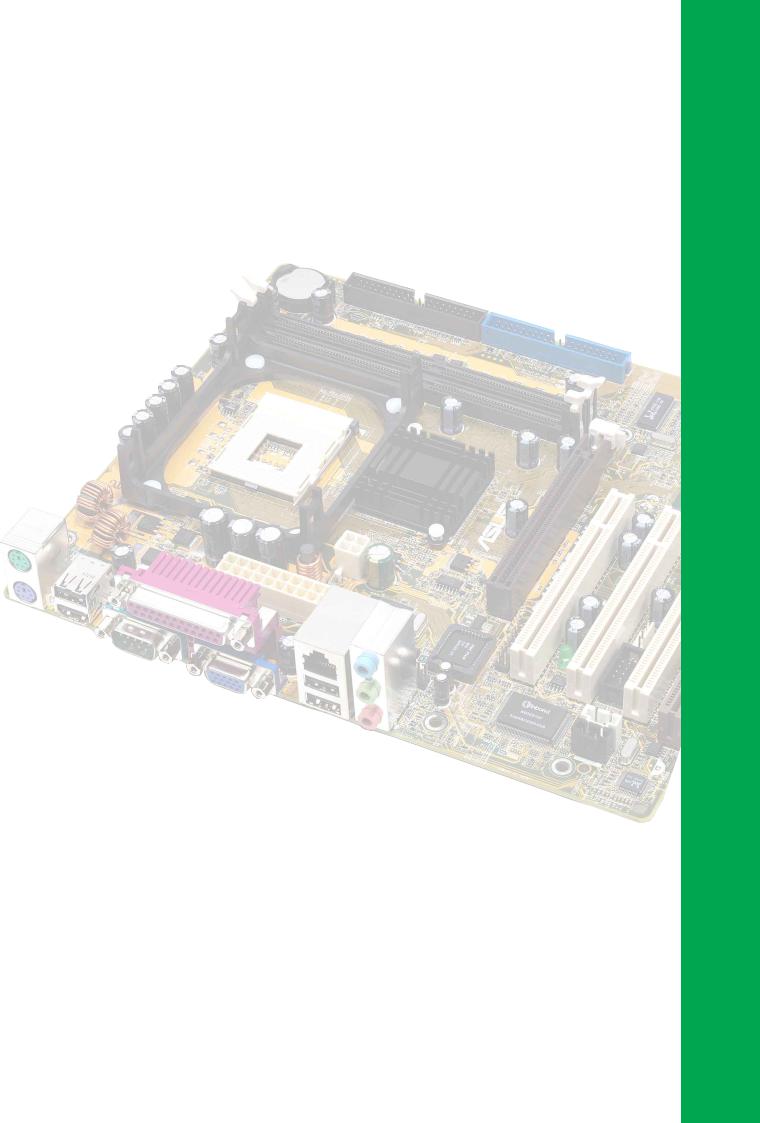
Chapter 1
This chapter describes the features of the P4VPMX motherboard. It includes brief descriptions of the motherboard components, and illustrations of the layout, jumper settings, and connectors.
Product introduction

1.1Welcome!
Thank you for buying the ASUS® P4VP-MX motherboard!
The ASUS P4VP-MX motherboard delivers a host of new features and latest technologies making it another standout in the long line of ASUS quality motherboards!
The P4VP-MX incorporates the Intel® Pentium® 4 Processor in 478-pin package with support for Intel®’s Hyper-Threading Technology and the Intel® Prescott CPU coupled with the VIA® VT8751A and VIA® VT8235 chipsets to set a new benchmark for an effective desktop platform solution.
Supporting up to 2GB of system memory with PC2100/PC1600 DDR SDRAM, high-resolution graphics via integrated VIA S3 ProSavage8 graphics and an AGP 4X slot, USB 2.0, and 6-channel audio features, the P4VP-MX is your affordable vehicle to enter the world of computing!
Before you start installing the motherboard, and hardware devices on it, check the items in your package with the list below.
1.2Package contents
Check your P4VP-MX package for the following items.
ASUS P4VP-MX motherboard ASUS P4VP-MX series support CD 1 x UltraDMA 133/100/66/33 cable 1 x Floppy disk cable
I/O shield
Bag of extra jumper caps User Guide
If any of the above items is damaged or missing, contact your retailer.
1-2 |
Chapter 1: Product introduction |

1.3Special features
Latest processor technology
The motherboard supports the latest Intel® Pentium® 4 and Prescott processors via a 478-pin surface mount ZIF socket. The Pentium 4 and Prescott processors include the new Hyper-Threading technology and allows up to 3.06+ GHz core frequencies for up to 4.2GB/s data transfer rates. See page 1-10.
Integrated VIA S3 ProSavage8 Graphics 
The VIA chipset integrates the VIA S3 ProSavage8 Graphics architecture to deliver realistic 3D/2D graphics with sharp images, fast rendering, smooth motion, and clearly defined details. This feature includes a maximum VGA operating memory size of 32MB and a maximum AGP aperture size of 256MB. See pages 1-6, 2-14.
Integrated 10/100 LAN
The VIA® VT8235 SouthBridge integrated MAC with the VIA® VT6103 PHY provides easy implementation of 10/100 Mbps Fast Ethernet LANs. See page 1-5.
USB 2.0 technology
The motherboard implements the new Universal Serial Bus (USB) 2.0 specification, extending the connection speed from 12 Mbps on USB 1.1 to a fast 480 Mbps on USB 2.0. See pages 1-6 and 1-20.
6-channel digital audio
The Realtek ALC655 AC’97 audio CODEC is onboard to provide 6-channel audio playback for 5.1 surround sound. See page 1-6.
ASUS EZ Flash BIOS
With the ASUS EZ Flash, you can easily update the system BIOS even before loading the operating system. No need to use a DOS-based utility or boot from a floppy disk. See page 2-3.
CrashFree BIOS 2
CrashFree BIOS 2 allows users to restore BIOS data from a floppy diskette or recovery CD when BIOS code and data are corrupted during upgrade or when invaded by a virus. ASUS motherboards now enable users to enjoy this protection feature without the need to pay for an optional ROM. See page 2-5.
ASUS MyLogo™
This new feature present in the motherboard allows you to personalize and add style to your system with customizable boot logos.
ASUS P4VP-MX motherboard |
1-3 |
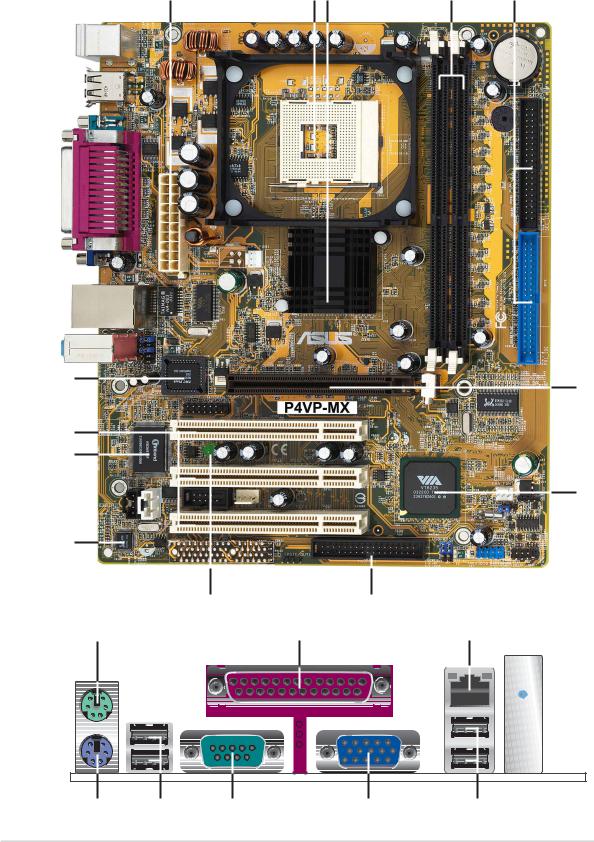
1.4Motherboard components
Before you install the motherboard, learn about its major components and available features to facilitate the installation and future upgrades. Refer to the succeeding pages for the component descriptions.
13
12
11
10
1 |
2 3 |
4 |
5 |
6
7
9 |
|
8 |
14 |
15 |
16 |
 17
17
 18
18
 19
19
24 |
23 |
22 |
21 |
20 |
1-4 |
Chapter 1: Product introduction |

1ATX power connector. This 20-pin connector connects to an ATX power supply.
2CPU socket. A 478-pin surface mount, Zero Insertion Force (ZIF) socket for the Intel® Pentium® 4 Processor, with 533/400 MHz system bus that allows 4.2GB/s, and 3.2GB/s data transfer rates, respectively.
3North bridge controller. The VIA® VT8751A provides the processor interface with 533/400 MHz frequency, system memory interface at 266MHz operation, and 1.5V AGP interface that supports AGP 2.0 specification including 4X Fast Write protocol.
4DDR DIMM sockets. These two 184-pin DIMM sockets support up to 2GB system memory using unbuffered non-ECC PC2100/PC1600 DDR DIMMs.
5IDE connectors. These dual-channel bus master IDE connectors support Ultra DMA133/100/66/33, PIO Modes 3 & 4 IDE devices. Both the primary (blue) and secondary (black) connectors are slotted to prevent incorrect insertion of the IDE ribbon cable.
6AGP 4X slot. This Accelerated Graphics Port (AGP) slot supports 1.5V AGP 4X mode graphics cards for 3D graphical applications.
7South bridge controller. The VIA® VT8235 integrated peripheral controller supports various I/O functions including 2-channel ATA/133 bus master IDE controller, up to six USB 2.0 ports, LPC Super I/O interface, AC’97 interface and PCI 2.2 interface.
8Floppy disk connector. This connector accommodates the provided ribbon cable for the floppy disk drive. One side of the connector is slotted to prevent incorrect insertion of the floppy disk cable.
9Standby power LED. This LED lights up if there is a standby power on the motherboard. This LED acts as a reminder to turn off the system power before plugging or unplugging devices.
10Audio CODEC. The Realtek ALC655 is an AC’97 CODEC that allows 6-channel audio playback.
11Super I/O controller. This Low Pin Count (LPC) interface provides the commonly used Super I/O functionality. The chipset supports a highperformance floppy disk controller for a 360K/720K/1.44M/2.88M floppy disk drive, a multi-mode parallel port, a Game/MIDI port and a standard compatible UART.
12PCI slots. These 32-bit PCI 2.2 expansion slots support bus master PCI cards like SCSI or LAN cards with 133MB/s maximum throughput.
13Flash ROM. This 3Mb firmware contains the programmable BIOS program.
14PS/2 mouse port. This green 6-pin connector is for a PS/2 mouse.
15Parallel port. This 25-pin port connects a parallel printer, a scanner, or other devices.
16RJ-45 port. This port allows connection to a Local Area Network (LAN) through a network hub.
ASUS P4VP-MX motherboard |
1-5 |

17Line In jack. This Line In (light blue) jack connects a tape player or other audio sources. In 6-channel mode, the function of this jack becomes Rear Speaker Out.
18Line Out jack. This Line Out (lime) jack connects a headphone or a speaker. In 6-channel mode, the function of this jack becomes Front Speaker Out.
19Microphone jack. This Mic (pink) jack connects a microphone. In 6-channel mode, the function of this jack becomes Bass/Center Speaker Out.
The functions of the Line Out, Line In, and Microphone jacks change when you select the 6-channel audio configuration as shown in the following table:
Audio 2, 4 or 6-channel configuration
|
Headphone/ |
|
|
|
2-Speaker |
4-Speaker |
6-Speaker |
Light Blue |
Line In |
Rear Speaker Out |
Rear Speaker Out |
|
|
|
|
Lime |
Line Out |
Front Speaker Out |
Front Speaker Out |
Pink |
Mic In |
Mic In |
Bass/Center |
20USB 2.0 ports 1 and 2. These two 4-pin Universal Serial Bus (USB) ports are available for connecting USB 2.0 devices.
21Video Graphics Adapter port. This 15-pin port is for a VGA monitor or other VGA-compatible devices.
22Serial port. This 9-pin COM1 port is for pointing devices or other serial devices.
23USB 2.0 ports 3 and 4. These two 4-pin Universal Serial Bus (USB) ports are available for connecting USB 2.0 devices.
24PS/2 keyboard port. This purple connector is for a PS/2 keyboard.
1-6 |
Chapter 1: Product introduction |
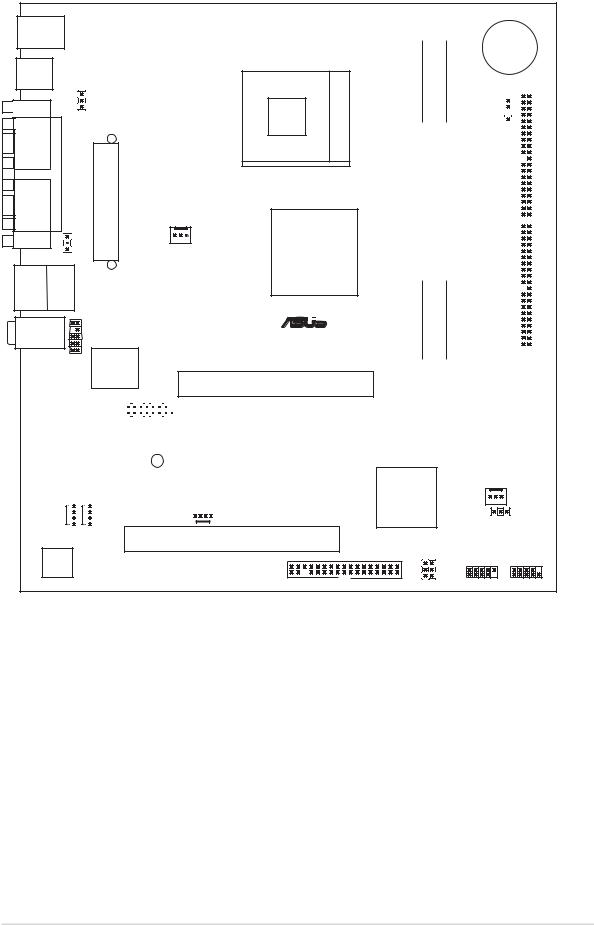
1.5Motherboard layout
PS/2
T: Mouse
B: Keyboard
USB3 |
|
|
USBPWR34 |
USB4 |
|
|
|
COM1 |
|
||
|
|
||
VGA |
PARALLEL PORT |
USBPWR12 |
ATX Power Connector |
|
|||
Bottom: |
Top: |
|
|
USB1 |
RJ-45 |
|
|
USB2 |
|
|
|
CPU_FAN1
Socket 478
VIA
VT8751

 ®
®
Top:Line In Center:Line Out Below:Mic In
AUDIO1 3Mbit
Flash
BIOS Accelerated Graphics Port
(AGP)
GAME1 















 P4VP-MX
P4VP-MX
|
|
|
|
|
|
|
PCI Slot 1 |
||
|
Super I/O |
|
|
||||||
|
|
|
|
|
|||||
LED1 |
|||||||||
|
|
|
|
|
|
||||
|
|
|
|
|
|
|
|
|
|
|
|
|
|
|
|
|
PCI Slot 2 |
||
|
|
|
|
|
|
|
|||
|
|
|
|
|
|
|
|
|
|
|
|
|
|
|
|
|
|
MODEM1 |
|
|
|
|
|
|
|
|
|
||
|
|
|
|
|
|
|
|
||
|
|
|
|
|
|
|
PCI Slot 3 |
||
CD1 AUX1 |
|
||||||||
Audio
Codec
FLOPPY1
|
|
|
|
|
CR2032 3V |
|||||
|
|
|
|
|
Lithium Cell |
|||||
|
|
|
|
|
CMOS Power |
|||||
-pin module) |
|
-pin module) |
|
|
|
|
|
|
||
|
|
|
|
|
|
|
||||
|
|
|
|
|
|
|
||||
|
|
|
|
|
|
|
||||
|
|
|
|
|
|
|
||||
|
|
|
|
|
|
|
||||
|
|
|
|
|
|
|
||||
|
|
|
|
|
|
|
||||
|
|
SPEAKER1 |
|
|
|
|||||
|
|
|
||||||||
|
|
|
|
|
||||||
(64 bit, 184 |
|
(64 bit, 184 |
|
|
|
|
|
SEC IDE |
||
|
|
|
|
|
|
|||||
DDR DIMM1 |
|
DDR DIMM2 |
|
|
|
|
|
|
||
0 |
1 |
|
2 |
3 |
|
|
|
|
|
PRI IDE |
|
|
|
|
|
|
|||||
|
|
|
|
|
|
|
||||
CHA_FAN1
VIA VT8235
CLRCMOS1
PLED1 |
USBPWR56 |
USB56 PANEL1
ASUS P4VP-MX motherboard |
1-7 |
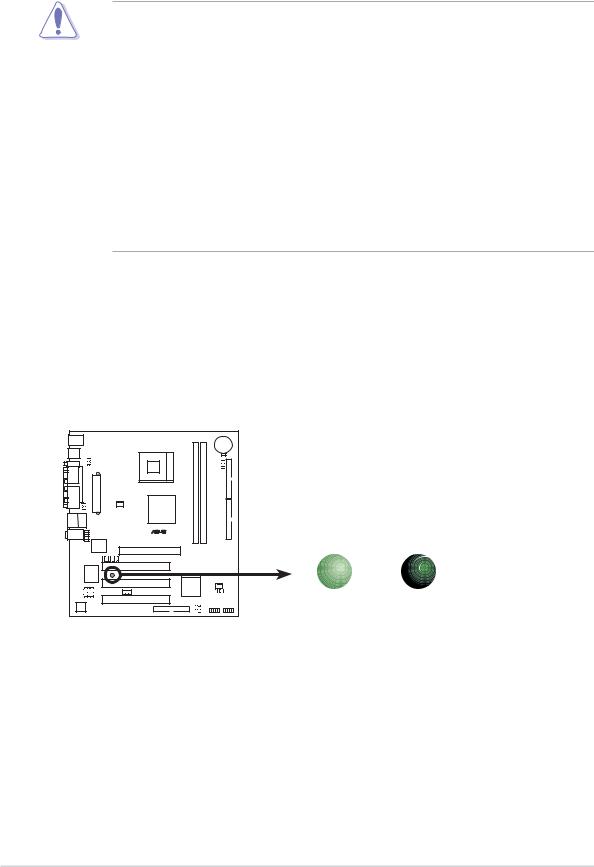
1.6Before you proceed
Take note of the following precautions before you install motherboard components or change any motherboard settings.
1. Unplug the power cord from the wall socket before touching any component.
2.Use a grounded wrist strap or touch a safely grounded object or to a metal object, such as the power supply case, before handling components to avoid damaging them due to static electricity.
3.Hold components by the edges to avoid touching the ICs on them.
4.Whenever you uninstall any component, place it on a grounded antistatic pad or in the bag that came with the component.
5.Before you install or remove any component, ensure that the ATX power supply is switched off or the power cord is detached from the power supply. Failure to do so may cause severe damage to the motherboard, peripherals, and/or components.
Onboard LED
The motherboard comes with a standby power LED. When lit, this green LED indicates that the system is ON, in sleep mode, or in soft-off mode, a reminder that you should shut down the system and unplug the power cable before removing or plugging in any motherboard component. The illustration below shows the location of the onboard LED.
|
|
LED1 |
P4VP-MX |
|
|
|
ON |
OFF |
|
Standby |
Powered |
P4VP-MX Onboard LED |
Power |
Off |
|
|
1-8 |
Chapter 1: Product introduction |
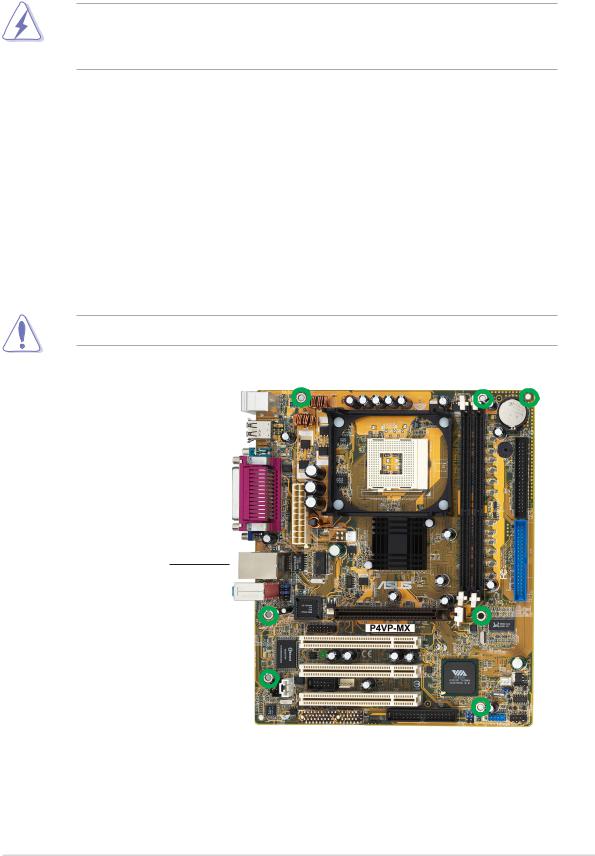
1.7Motherboard installation
Before you install the motherboard, study the configuration of your chassis to ensure that the motherboard fits into it. The motherboard uses the micro-ATX form factor that measures 9.6 inches x 8.0 inches (24.5 cm x 20.5 cm).
Make sure to unplug the power cord before installing or removing the motherboard. Failure to do so may cause you physical injury and damage motherboard components.
1.7.1 Placement direction
When installing the motherboard, make sure that you place it into the chassis in the correct orientation. The edge with external ports goes to the rear part of the chassis as indicated in the image below.
1.7.2 Screw holes
Place seven (7) screws into the holes indicated by circles to secure the motherboard to the chassis.
Do not overtighten the screws! Doing so may damage the motherboard.
Place this side towards the rear of the chassis
ASUS P4VP-MX motherboard |
1-9 |
